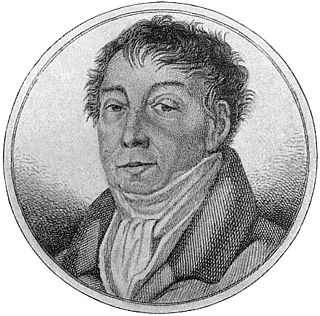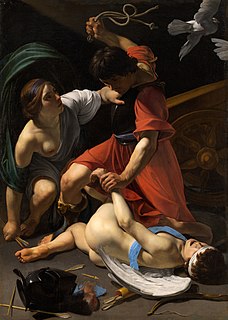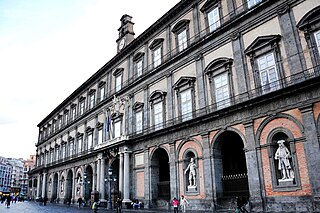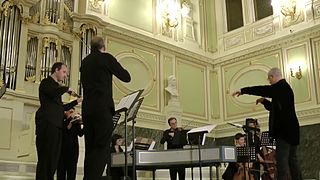Related Research Articles

Masaniello was an Italian fisherman who became leader of the revolt against the rule of Habsburg Spain in Naples in 1647.

Francesco Minerva was an Italian Roman Catholic prelate; at his death he was the second-oldest living bishop in the Roman Catholic Church, after Corrado Bafile. He was also one of its longest-serving priests, having been ordained on 16 April 1927.

Luigi Marchesi was an Italian castrato singer, one of the most prominent and charismatic to appear in Europe during the second half of the eighteenth century.

The Caravaggisti were stylistic followers of the late 16th-century Italian Baroque painter Caravaggio. His influence on the new Baroque style that eventually emerged from Mannerism was profound. Caravaggio never established a workshop as most other painters did, and thus had no school to spread his techniques. Nor did he ever set out his underlying philosophical approach to art, the psychological realism which can only be deduced from his surviving work. But it can be seen directly or indirectly in the work of Rubens, Jusepe de Ribera, Bernini, and Rembrandt. Famous while he lived, Caravaggio himself was forgotten almost immediately after his death. Many of his paintings were reascribed to his followers, such as The Taking of Christ, which was attributed to the Dutch painter Gerrit van Honthorst until 1990. It was only in the 20th century that his importance to the development of Western art was rediscovered. In the 1920s Roberto Longhi once more placed him in the European tradition: "Ribera, Vermeer, La Tour and Rembrandt could never have existed without him. And the art of Delacroix, Courbet and Manet would have been utterly different". The influential Bernard Berenson stated: "With the exception of Michelangelo, no other Italian painter exercised so great an influence."

Jusepe de Ribera was a Spanish Tenebrist painter and printmaker, also known as José de Ribera and Josep de Ribera. He also was called Lo Spagnoletto by his contemporaries and early writers. Ribera was a leading painter of the Spanish school, although his mature work was all done in Italy.
Events from the year 1570 in art.
Sersale is a comune in the province of Catanzaro in the Calabria region of Italy. As of 2013, Sersale had an estimated population of 4,701. Sersale was founded in 1620. It was named after a baron named Francesco Sersale who owned a large amount of land in the area surrounding the present borders of Sersale. Francesco Sersale and his family came from Naples. There are records of this family in that area from as far back as 1271.
The Naples Conservatory of Music is a music school located in Naples, Italy. It is situated in the complex of San Pietro a Majella.

The Royal Palace of Naples is a palace, museum, and historical tourist destination located in central Naples, southern Italy.
Events from the year 1690 in art.

Paolo Domenico Finoglia, or Finoglio, was an Italian painter of the early-Baroque period, active mainly in South Italy, including Naples and towns in Apulia.

Cappella Neapolitana is an early music ensemble based in Naples and dedicated to the recovery of Neapolitan musical heritage, primarily from the baroque era.
Giovanni Salvatore (ca.1620–ca.1688) was a Neapolitan composer and organist.
Giovanni Maria Sabino was an Italian composer, organist and teacher.
Antonio Nola was a Neapolitan composer of whom little biographical information or music survives. He is to be distinguished from the better known Giovanni Domenico da Nola born 130 years earlier.
Erasmo Bartoli Filippino or Erasmo di Bartolo, called padre Raimo (1606–1656), was an Italian priest, composer, and teacher at the conservatories in Naples.
Donato Antonio «Antonino» Sabino was an Italian composer and priest. He was brother of Giovan Maria Sabino, another composer-priest, and uncle of Francesco Sabino.
Francesco Buzomi (1576–1639) was an Italian missionary in Vietnam. He was one of the first Catholic missionaries in Đàng Trong and, along with others such as Francisco de Pina, Girolamo Maiorica and Alexandre de Rhodes, belonged to the generation of Jesuit priests in the first half of the 17th century who established the firm foundation of the Catholic Church in Vietnam.
Nicola Sabini was an Italian composer of the mid-Baroque period who spent his career in Naples. An influential figure in early Neapolitan opera buffa, his most important opera is the 1701 comedy Scherzo drammatico, Il mondo abbattuto.
References
- ↑ Dinko Fabris Music In Seventeenth-century Naples: Francesco Provenzale (1624-1704) 2007 Page 54 "Francesco Sabino, too, was a near relation of the other two musicians. He was born in Naples in 1620, ..